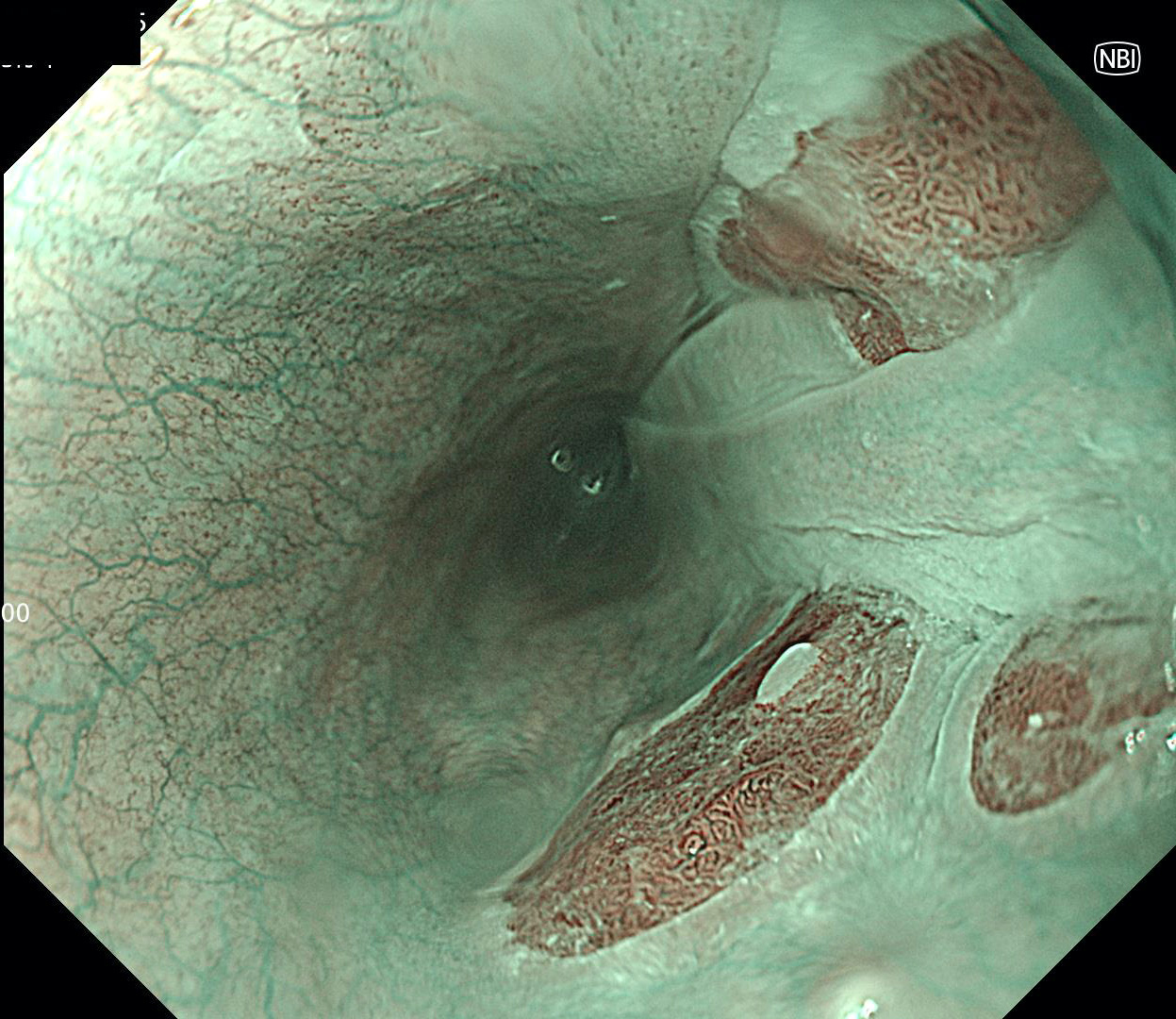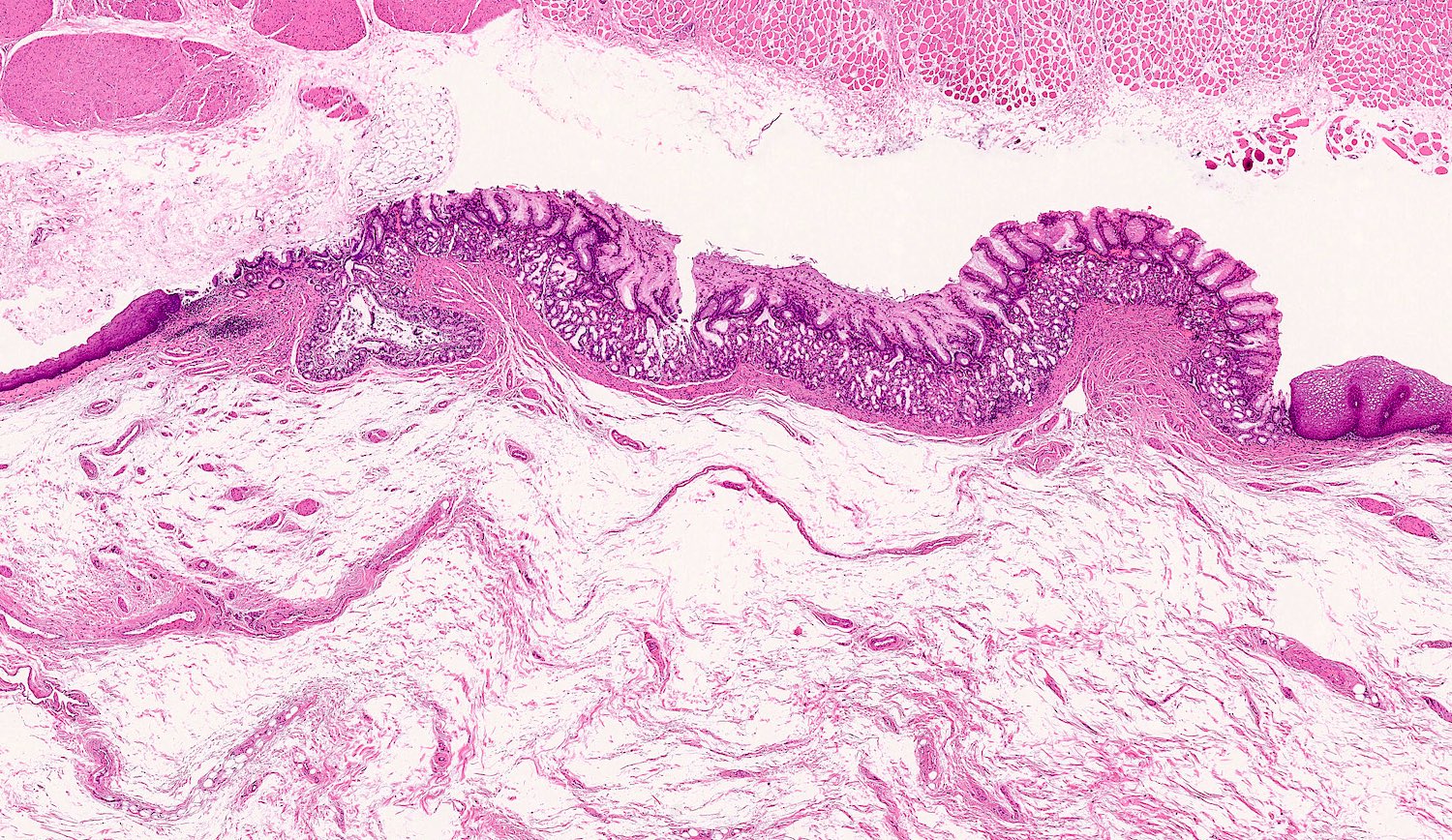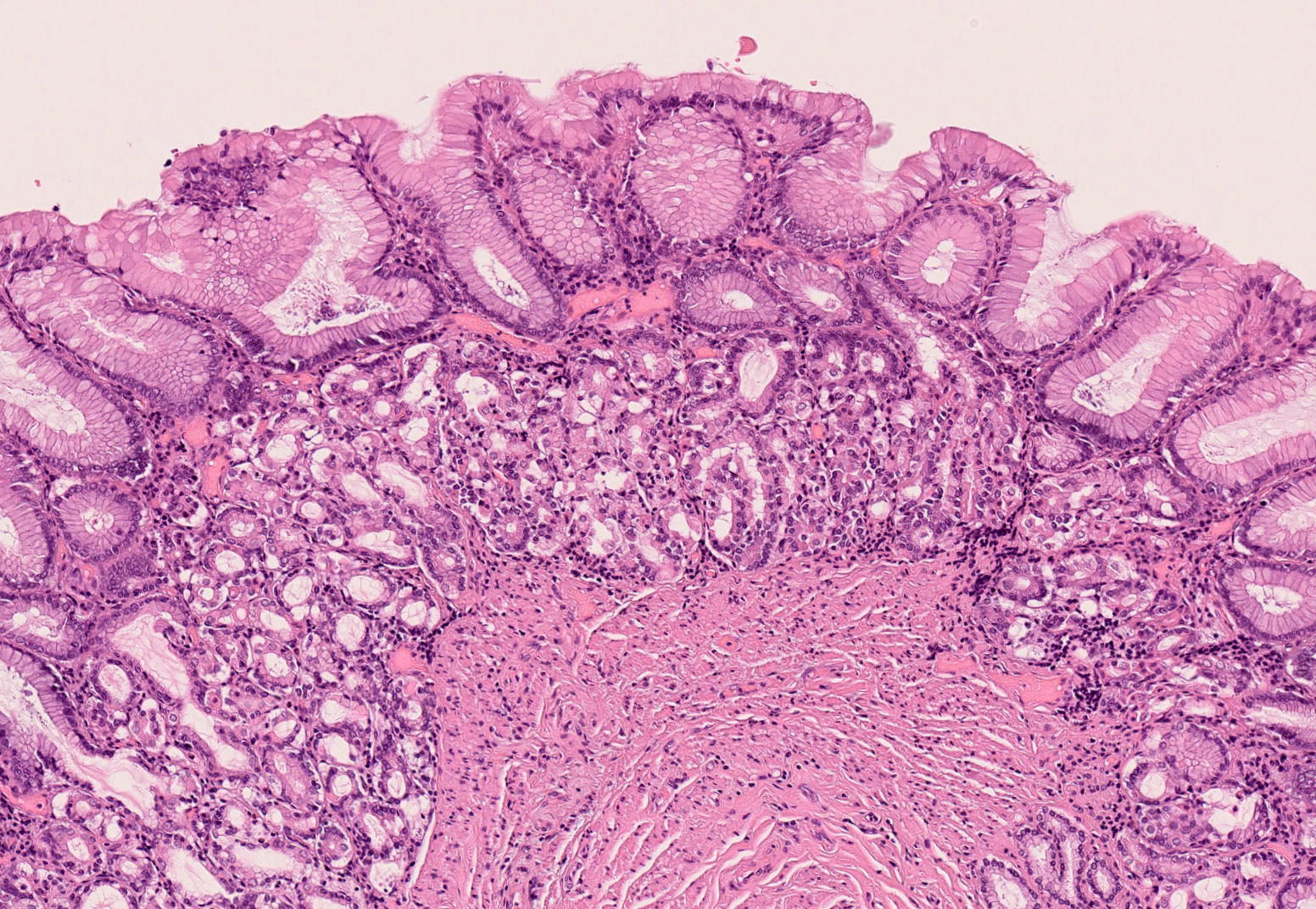Table of Contents
Definition / general | Essential features | Terminology | ICD coding | Epidemiology | Sites | Pathophysiology | Etiology | Clinical features | Diagnosis | Case reports | Treatment | Clinical images | Gross description | Gross images | Microscopic (histologic) description | Microscopic (histologic) images | Sample pathology report | Differential diagnosis | Board review style question #1 | Board review style answer #1 | Board review style question #2 | Board review style answer #2Cite this page: Tateishi Y, Nakanishi Y. Heterotopic gastric mucosa. PathologyOutlines.com website. https://www.pathologyoutlines.com/topic/esophagusectopicgastric.html. Accessed April 1st, 2025.
Definition / general
- Heterotopic gastric mucosa, most commonly seen in the postcricoid / cervical esophagus
- Usually composed of fundic / oxyntic type gastric mucosa admixed with mucous glands
Essential features
- Can be seen in both genders at all ages
- Usually asymptomatic
- Most common in the postcricoid region / cervical esophagus
- Single or multiple sharply demarcated circular pink to red area(s) (usually ~1 cm in size) in the cervical esophagus
- Usually composed of fundic / oxyntic type gastric mucosa admixed with mucous glands
- No treatment unless symptomatic
Terminology
- Inlet patch
- Cervical inlet patch
- Ectopic gastric mucosa
ICD coding
- ICD-10: K22 - other diseases of esophagus
Epidemiology
- Can be seen in all ages and both genders with an incidence of 1 - 15% (Adv Med Sci 2021;66:170, BMC Gastroenterol 2017;17:87, J Pediatr 2016;176:99)
Sites
- Most common in the postcricoid region / cervical esophagus (BMC Gastroenterol 2017;17:87, J Pediatr 2016;176:99)
Pathophysiology
- Congenital abnormality resulting from an incomplete embryonic esophageal epithelization process (the embryonic esophagus lined by columnar epithelium undergoes gradual replacement of columnar epithelium with squamous epithelium starting from the middle of the esophagus with vertical extension in both directions)
Etiology
- No known etiologic factors to cause above mentioned embryonic abnormality
Clinical features
- Can be seen in both genders at all ages (no significant difference)
- Usually asymptomatic but rare patients present with dysphasia, globus sensation, cough, sore throat, hoarseness, excessive throat clearing, among others (Adv Med Sci 2021;66:170, BMC Gastroenterol 2017;17:87, J Pediatr 2016;176:99)
Diagnosis
- Esophagogastroduodenoscopy with biopsy
- Narrow band imaging (NBI) increases the detection rate (Adv Med Sci 2021;66:170)
Case reports
- 44 year old woman with chronic dysphagia and globus sensation due to multiple inlet patches underwent esophageal dilation and proton pump inhibitor therapy, resulting in a resolution of her symptoms (Cureus 2023;15:e33459)
- 52 year old man with dysphagia caused by Helicobacter pylori associated inlet patch ulcer (ACG Case Rep J 2020;7:e00405)
- 59 year old man with esophageal adenocarcinoma arising from circumferential ectopic gastric mucosa (J Gastroenterol Hepatol 2022;37:47)
- 65 year old man with alpha fetoprotein (AFP) producing esophageal carcinoma arising from ectopic gastric mucosa in the cervical esophagus (J Gastrointestin Liver Dis 2017;26:193)
Treatment
- No treatment for asymptomatic patients
- Eradication of H. pylori if positive for H. pylori in heterotopic gastric mucosa
- Proton pump inhibitor (PPI) for symptomatic patient (Frontline Gastroenterol 2018;9:214)
- Argon plasma coagulation (APC) or radiofrequency ablation (RFA) for symptomatic patient (Gastrointest Endosc 2016;84:1022, Dig Endosc 2018;30:212, J Pediatr 2016;176:99)
- Endoscopic resection for dysplasia and adenocarcinoma arising from heterotopic gastric mucosa (Expert Rev Gastroenterol Hepatol 2016;10:405, Gastrointest Endosc 2015;81:1297)
Gross description
- Single or multiple sharply demarcated circular pink to red area(s) in the postcricoid region / cervical esophagus
Microscopic (histologic) description
- Heterotopic gastric mucosa with fundic / oxyntic type glands admixed with mucous glands surrounded by squamous mucosa
- Helicobacter pylori and intestinal metaplasia can be rarely seen
Microscopic (histologic) images
Sample pathology report
- Esophagus, proximal, biopsy:
- Heterotopic gastric mucosa
- Negative for dysplasia or malignancy
Differential diagnosis
- Barrett esophagus:
- Specialized columnar mucosa at the esophagogastric junction / lower esophagus
- Heterotopic pancreatic tissue:
- Presence of pancreatic acinar cells
- Heterotopic sebaceous glands:
- Presence of sebaceous glands
- Adenocarcinoma:
- Cytological and structural atypia with invasive growth
Board review style question #1
Which of the following statements regarding the histologic features of heterotopic gastric mucosa of the esophagus is true?
- Characterized by the presence of gastric type mucosa with intestinal metaplasia
- Double muscularis mucosae is one of the characteristic findings
- Most often contains oxyntic type gastric glands
- Usually associated with significant inflammation
Board review style answer #1
C. Most often contains oxyntic type gastric glands. Heterotopic gastric mucosa is most often composed of an admixture of oxyntic type gastric glands and mucous glands. Intestinal metaplasia, significant inflammation and double muscularis mucosae are not common findings of heterotopic gastric mucosa.
Comment Here
Reference: Heterotopic gastric mucosa
Comment Here
Reference: Heterotopic gastric mucosa
Board review style question #2
Which of the following statements about heterotopic gastric mucosa of the esophagus is true?
- Often associated with Barrett esophagus
- Patients often present with dysphagia
- Rare cases of adenocarcinoma arising from heterotopic gastric mucosa have been reported
- Surrounding background mucosa should be examined carefully due to possible association with squamous cell carcinoma or squamous dysplasia
Board review style answer #2
C. Rare cases of adenocarcinoma arising from heterotopic gastric mucosa have been reported. Adenocarcinoma arising from heterotopic gastric mucosa is extremely rare but rare cases of adenocarcinoma arising from heterotopic gastric mucosa have been reported. Association with Barrett esophagus is controversial. No association with squamous cell carcinoma or squamous dysplasia. Most patients are asymptomatic.
Comment Here
Reference: Heterotopic gastric mucosa
Comment Here
Reference: Heterotopic gastric mucosa











